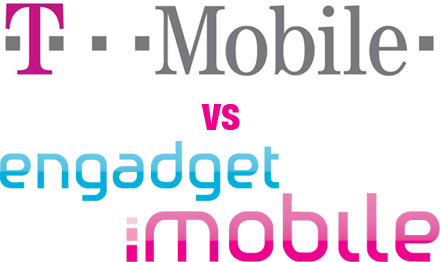I was sure that this was an April Fool's joke. But alas, it's true. Deutsche Telekom, the parent company of T-Mobile, sent Engadget a letter a few weeks ago, requesting that the popular tech blog stop using the color magenta in the logo for its Engadget Mobile news blog. Here are the two logos side-by-side (courtesy of Engadget):
The letter, which is available on Engadget, states that T-Mobile has been "using the color magenta as a company identifier and core branding element for years," and that "the company therefore holds trademark protection for the use of this color in connection with its products and services in many territories around the world." The letter goes on, in an uncommonly polite tone for a C&D, to indicate that customers might be confused about T-Mobile's relationship to the blog. Even more diplomatically, it continues: "we would therefore appreciate if you would replace the color magenta in the Engadget Mobile logo and discontinue using the color in a trademark-specific way on your website." The letter concludes with a request that Engadget "respond with any comments" within two weeks. T-Mobile's public relations folks deny that this is a cease-and-desist letter at all (which is a plausible reading), indicating instead that it was meant to "open a dialogue." It's no surprise that T-Mobile is treading lightly. Not only is its trademark claim weak, but Engadget has potentially significant influence with mobile phone customers.
For its part, Engadget doesn't see the letter as a request or invitation to dialogue, but as a demand (also a plausible reading). And the blog is responding accordingly -- posting the letter, publicizing T-Mobile's overreaching, and adding a healthy dose of ridicule:
A bunch of other tech and mobile phone bloggers have "gone magenta" in solidarity with Engadget (here, here, here, and here).
I don't know what the T-Mobile lawyers were thinking. This is not quite as bad as some recent cases, where plaintiffs have tried to use trademark law to silence criticism, like in Wal-Mart v. Smith and BidZirk v. Smith (different Smiths). Here, we have just an incredibly aggressive idea of what trademark can protect and a poor argument that any consumer confusion is likely. On top of that, these lawyers should know by now that shooting off a shaky C&D (or whatever it is) to a blog with a large and enthusiastic readership is an invitation to a public relations nightmare.
Hat tip to Ron Coleman.






